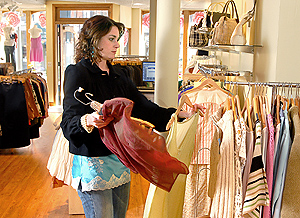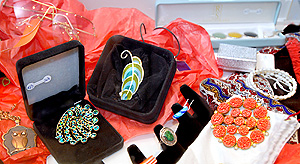
WHEN A USED HANDBAG IS SELLING FOR $998 and flies off the shelf in less than 24
hours, something’s up. And when things like that happen every day in 11 stores around
New England, “something” is one of the most successful consignment stores in the
area: Second lime Around.
Sarah Hill looked through a lens and saw her old jeans, a still newly creased jacket,
and her favorite worn-in pair of boots.
The Falmouth resident hadn't the heart to toss them; she'd already tried to hand
them off.
Of course, her friends -- at least the ones who wore her size -- didn't have room
in their heaping closets either.
So there lay a pile of wardrobe regret, growing through shopping excursions and
spring cleaning.
Until one day, four years ago, Hill, a teacher at the Governor Baxter School for
the Deaf, put the problem into focus and developed the picture-perfect plan.

WHEN
A USED HANDBAG IS SELLING FOR $998 and flies off the shelf in less than 24 hours,
something’s up. And when things like that happen every day in 11 stores around New
England, “something” is one of the most successful consignment stores in the area:
Second lime Around.
Using a digital camera, she posted her clothes on eBay and Craigslist, and with
that discovered her old outfit was worth more than a sentiment. In came $40 for
a pair of $150 Citizens of Humanity jeans; $100 for the boots she paid twice that
for a few years earlier.
Out went the pile from her closet. She discovered selling old clothes second hand
is as satisfying as buying them --Ýsince it's made her $2,000.
"A lot of my friends resell their old clothes to buy new clothes. It enables their
shopping," said Hill. "I put the money in my savings account. It's like income that
I'm not expecting."
In today's fashion, frayed and tattered sells. Recycling is in, artificial anything
is out, and manufactured fading is just so five years ago.
U.S. consumers have an increased awareness of the importance in reducing pointless
waste. Things are progressing from a disposable society to a recycling society --
fashion included. A good thrift store is no longer Goodwill and Salvation Army,
it's high-end retailer look-alikes. New malls are online used-clothing auctions.
Consumers are the sellers.
The popularity of clothing resale is chasing that of shopping itself -- whether
in consignment stores, on sites like Craigslist, or flipping them for a profit on
sites like eBay, where you'll find more than 2 million items of clothes, shoes and
accessories.
Bottom line is you don't have to be rich to dress like it. Just a savvy second-hand
seller.

WHEN A
USED HANDBAG IS SELLING FOR $998 and flies off the shelf in less than 24 hours,
something’s up. And when things like that happen every day in 11 stores around New
England, “something” is one of the most successful consignment stores in the area:
Second lime Around.
"Within the last five years, there is no longer a negative stigma with used clothing,"
said Jessica Powers, manager of Second Time Around, Portland's newest consignment
store on Fore Street. "If you read any of the fashion magazines, now they're focused
on environment and recycling."
The chain's new store has arrived along with an increasing number of high-quality
items sold second hand at a fraction of the price, nationally.
According to the National Association of Resale & Thrift Shops, resale continues
to be one of the fastest-growing segments of retail thanks to more value-conscious
shoppers.
The association reported the industry has experienced a growth of approximately
5 percent a year in recent years, with now more than 20,000 national resale, consignment
and thrift shops.
While approximately 33 percent of Americans shop at thrift and consignment stores
during a given year, only 12 percent shop in factory outlets, 20 percent in apparel
stores, and 21 percent in major department stores, according to America's Research
Group. Stores like Second Time Around are specializing in newer, high-end, designer,
gently worn items instead of 1970s garb.
Inside the new store, shiny open wooden floors and exposed brick and beams dress
up sleek suits, pencil-straight jeans and one-of-a-kind frilly spring blouses outside
the context of an overcrowded closet. The curb appeal of the old building and garb
alike could pass for a neighboring high-end boutique until shoppers get a flash
of the humbling prices.
The 11th and newest branch of Second Time Around, which opened last month in the
middle of the Old Port's Fore Street, carries your Nanette Lepore, Eileen Fisher
and Three Dots; there are also names more familiar to locals, clothes from the Gap,
Banana Republic or J.Crew.
Owner Jeff Casler, who has stores in Boston, Providence and Portsmouth, markets
bright spring colors in sharp styles to anyone with an appreciation for clothing,
or longing for a sophisticated vacation from overspending.
"If you recycle your clothes for a profit, you don't feel as guilt y about buying
clothing," said Powers.
In just a few weeks, Second Time Around's Portland branch has 62 consignors. In
the last seven years, Forget-Me-Nots, of Falmouth, has dealt with nearly 5,000.
"The biggest change is there is more younger consignors. When we first started they
didn't want to wear used clothes. There was a negative stigma associated with it.
It's interesting to see how much that's changed," said M.J. Spurr, owner of Forget-Me-Nots.
Both stores offer consignors 50 percent of the selling price. But with resale prices
equivalent to about 50 percent of the original price, many like Hill aim to swing
a larger profit online.
"Craigslist is easy, but there's not always much interest. eBay is a process. There's
a small fee, but people from all over see them so it's worth it. It's best to include
the shipping," she suggested.
She said another technique to reselling on eBay (there are many) is making sure
to list items based on the prices of alike items online. And, once in a while, if
you're really lucky, your clothes may even appreciate in value.
"Sometimes I buy clothes from stores at discount prices, and resell them on eBay
for a profit," Hill admitted.
Today, she still loves clothes; but shopping means selling more often than buying.
"I'm sick of having too many clothes. Now, I have a few key pieces," Hill said.
"I get one nice piece of clothing, wear it a lot and resell it when I get sick of
looking at it."
And she still doesn't bother with spring cleaning. Only now because she doesn't
have to.